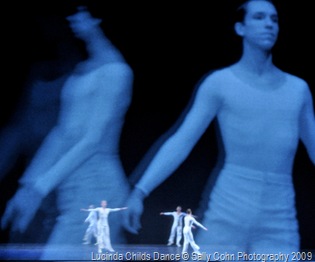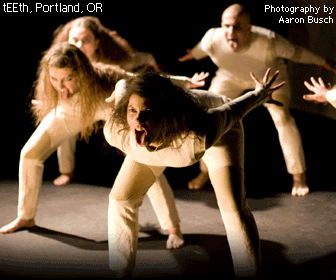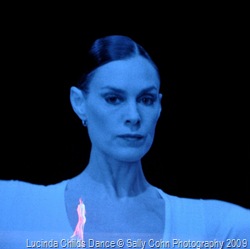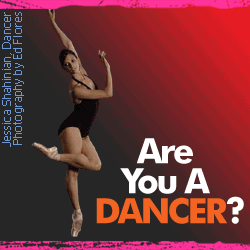Dance Review: What the Human Body Can Do, Lucinda Childs Dance at The Joyce Theater
October 9, 2009 by iDANZ Today
Filed under Concert Modern -Jazz-Contemporary, iDANZ Critix Corner -Dance Reviews, iDANZ Features, Reviews
 Rid your mind of the notion that dancers are just like real people – capable of clumsiness, dragging feet, spatial confusion and other characteristics that typically unite human beings – and then you will be ready to see Lucinda Childs Dance at The Joyce Theater. Unless you do this, you will spend two precious hours of your truly human life wondering where you went wrong while blaming your parents for their imperfect gene pool. Luckily I have always known that dancers are cut from a different cloth and am able to enjoy myself despite an awestruck expression I wore like a mask.
Rid your mind of the notion that dancers are just like real people – capable of clumsiness, dragging feet, spatial confusion and other characteristics that typically unite human beings – and then you will be ready to see Lucinda Childs Dance at The Joyce Theater. Unless you do this, you will spend two precious hours of your truly human life wondering where you went wrong while blaming your parents for their imperfect gene pool. Luckily I have always known that dancers are cut from a different cloth and am able to enjoy myself despite an awestruck expression I wore like a mask.
Childs’ concert opens with Concerto revived from 1993. The lights come up on two black clad figures as still and majestic as statues. Within seconds they seem to literally take flight while lending each movement the focus of their initial stillness whether it be a rapid turn in attitude or a perfect triple pirouette. Technique oozes from these dancers pores. These seven dancers have not missed a technique class in years of that you can be sure. One horizontally crossing phrase is repeated and deconstructed over and over again taking advantage of every inch of the gleaming marley. Henryk Gorecki’s Mario Brothers-esque score pulsates through the theater like a record that goes back to the same spot. This of course assumes that the writers of the Mario Brothers video game music meant for it to marry all things jarring and intoxicating. Katherine Fisher stands out as a sprightly mover I cannot help but watch as she dances like a gymnast going for a perfect ten. Throughout the concert, Fisher earns that very score in my book.
 After these profoundly precise movers end to thunderous applause, the stage is graced by Ms. Child’s herself. Her erect posture informs the audience in one second that her company members learned from her image – a living legend whom demands the very poise and grace she evokes with the simple lift of one arm. Revived from 2001, Largo takes Childs’ across the stage with footwork so delicate I wonder if she choreographed the piece or if this is simply what she prefers to walking. The women next to me tell me they saw Childs’ dance decades ago and as they squeeze my arm, eyes widening and say “my God she’s always been amazing,” I feel guilty for not being alive to have witnessed her dance before. I blame my parents a second time before intermission.
After these profoundly precise movers end to thunderous applause, the stage is graced by Ms. Child’s herself. Her erect posture informs the audience in one second that her company members learned from her image – a living legend whom demands the very poise and grace she evokes with the simple lift of one arm. Revived from 2001, Largo takes Childs’ across the stage with footwork so delicate I wonder if she choreographed the piece or if this is simply what she prefers to walking. The women next to me tell me they saw Childs’ dance decades ago and as they squeeze my arm, eyes widening and say “my God she’s always been amazing,” I feel guilty for not being alive to have witnessed her dance before. I blame my parents a second time before intermission.
After intermission Dance, revived from 1979 and set to music by the Phillip Glass Ensemble begins. This piece is broken down into three sections, Dance 1, 2 and 3. Much like Concerto two dancers begin with a rapid horizontally crossing phrase, only this time they are in white instead of black. Within moments, I am again reminded of the physical prowess of the eight company members darting in and out of spatial configurations rivaling a kaleidoscope. A video of earlier company members including Childs is projected atop the physically present dancers. The projection is magnified so extremely that I can see everything from the stomach muscles to the laugh lines of the projected dancers. I thought I was viewing a kaleidoscope before, but now I am convinced that these dancers have their energy fueled by superpowers as they share their space with the projected dancers who can never tire because they are not real. Frankly, I would be a little perturbed.
Again, I am drawn to Katherine Fisher who seems to never tire in spite of this dance that seems like both a sprint and a marathon to me, and all I’m doing is sitting on my butt.
 Dance 2 is a solo performed by Caitlin Scranton. As she delves into the footwork as delicate as Childs, I start to wonder if she borrowed bits from this piece for Largo. Several arm postures bring my mind back to Largo, and I can only imagine the pressure Scranton must feel to evoke Childs’ pose. Scranton is not alone onstage as a projection of an earlier dancer so physically similar performs the same choreography. At times the video is reversed so Scranton and the projection seem to be dancing towards one another, and at other times, I find myself drawn to the video image not because she is more compelling than Scranton but because she is so large and lifelike I feel like she is the Patron Saint of Dance and there’s no turning away.
Dance 2 is a solo performed by Caitlin Scranton. As she delves into the footwork as delicate as Childs, I start to wonder if she borrowed bits from this piece for Largo. Several arm postures bring my mind back to Largo, and I can only imagine the pressure Scranton must feel to evoke Childs’ pose. Scranton is not alone onstage as a projection of an earlier dancer so physically similar performs the same choreography. At times the video is reversed so Scranton and the projection seem to be dancing towards one another, and at other times, I find myself drawn to the video image not because she is more compelling than Scranton but because she is so large and lifelike I feel like she is the Patron Saint of Dance and there’s no turning away.
Finally Dance 3 begins and this is when the videographer, Sol LeWitt, pulls out all of the stops. Eight dancers, in a slightly different group of eight than in Dance 1, are joined by dancers projected in one of three ways. They are either projected on the level of the stage so they seem to be in the dancer’s exact space, or projected at an angle against the edge of the stage so at times they coincide, or they are projected directly atop the real dancers resembling a ‘name the seven differences’ puzzle at the end of People Magazine. Most of the time, I cannot name the difference.
The audience erupts into applause creating a need for the company to bow no less than four times.
It feels a little sacrilegious to say what I’m about to say because of my respect for Childs and all that her career has brought to the world of dance. However, after Concerto, I got tired of seeing perfection without a trace of humanity. I find the latter makes me forgiving of the former. It makes me believe that the dancers are more than robots. In Concerto and Dance 3, I see sweat spinning in opposition to the wild circles they danced, in their stillness I see ribcages rise and fall from exhaustion, during the bows I see smiles of pride and accomplishment – these three pieces alone stitch the fabric of a human life. But in the moments that shatter all traditionally human prowess, I see deadpan faces. I see no hints of teeth. I understand the furrowed brows but just once I want to believe that something, as extraordinary as their footwork, sends them back and forth across the stage when surely all reason in their bodies tells them to stop. But maybe that’s the thing – Childs demands something so superhuman from her truly human dancers that the switch that turns on joy is put on pause. By the time the forth bow is happening the switch has been obliterated, and I see glorious humanity….. Ahhhh. Go see Childs to see what the human body can do.
 iDANZ Critix Corner
iDANZ Critix Corner
Official Dance Review by Eileen Elizabeth
Performance: Lucinda Childs Dance
Choreography: Lucinda Childs
Venue: The Joyce Theater, New York City
Performance Date: Tuesday, October 6, 2009
www.iDANZ.com
Click Here To Become a Member of iDANZ.com Today!
The More Members We Have, The More We Can Make a Difference. It’s Free!
iDANZ – The Social Network Where Dancers Live!
Want to stay connected to iDANZ? Join our network using the following services: 







